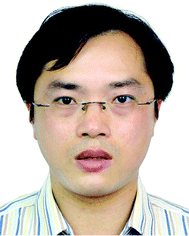Stimuli-responsive materials: a web themed collection
Feihe
Huang
a,
Xi
Zhang
b and
Ben Zhong
Tang
c
aState Key Laboratory of Chemical Engineering, Center for Chemistry of High-Performance & Novel Materials, Department of Chemistry, Zhejiang University, Hangzhou 310027, P. R. China. E-mail: fhuang@zju.edu.cn
bThe Key Lab of Organic Optoelectronics & Molecular Engineering, Department of Chemistry, Tsinghua University, Beijing 100084, P. R. China. E-mail: xi@mail.tsinghua.edu.cn
cDepartment of Chemistry, Hong Kong Branch of the Chinese National Engineering Research Center for Tissue Restoration and Reconstruction, and Division of Biomedical Engineering, Hong Kong University of Science and Technology, Clear Water Bay, Kowloon, Hong Kong, China. E-mail: tangbenz@ust.hk
 Xi Zhang | Xi Zhang is currently a Professor of Chemistry in the Department of Chemistry at Tsinghua University. His research focuses on molecular engineering of functional supramolecular systems. |
Stimuli-responsive materials, whose functions/properties can be altered and controlled by external stimulations, have become a hot topic of increasing interest recently. The range of stimuli-responsive materials is broad. They have appeared in the literature as coatings, crystals, plastics, rubbers, fibers, hydrogels, micelles, vesicles, actuators, and aerogels. The building blocks used to fabricate them include not only organic molecules, polymers and biomolecules based on covalent bonds but also various inorganic species and organic–inorganic hybrids. Furthermore, supermolecules, aggregates based on noncovalent bonds, represent another class of useful building blocks of stimuli-responsive materials. External stimuli include pH, temperature, light, redox agents, solvent, enzymes, ions, gas, mechanical force, electric field, magnetic field, and so on. Stimuli-responsiveness of stimuli-responsive materials can be reflected as change of shape, color, function, and/or other physical/chemical properties along with external stimulation. Sometimes, the reversible and tunable nature of such a response endows them with important properties of controllability and reversibility. These features can endow these materials with fascinating functionalities including shape memory, controlled release and self-healing, and allow their use in a range of applications such as information storage, imaging, switchable catalysis, sensing, molecular electronics, drug delivery, gene transportation, cell culture, tissue regeneration, and smart/adaptive materials and devices. Further research on stimuli-responsive materials may lead to the fabrication of next-generation smart materials with predictable, changeable, and controllable properties/functions based on precision chemistry.
The articles included in this web themed collection can not only provide a broad view of stimuli-responsive materials but also represents the state-of-the-art work going on currently in this field. However, undoubtedly new research directions and branches will be investigated in the near future. We hope that the readers will enjoy reading these excellent articles and get some inspiration from them. Finally, we want to give our deep acknowledgements to the contributors of this web themed collection since their important contributions make this themed collection an excellent one.
| This journal is © the Partner Organisations 2019 |


